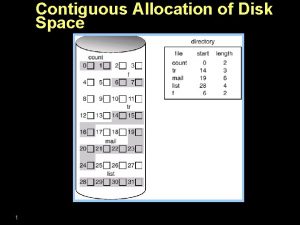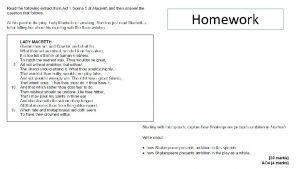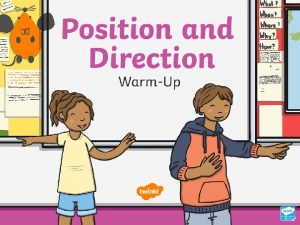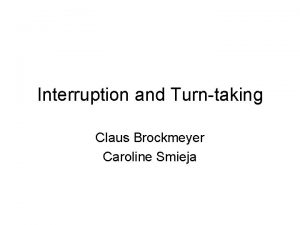Turntaking in conversation Turn allocation Turn allocation At








- Slides: 8

Turn-taking in conversation: Turn allocation

Turn allocation • At any TRP, there are two basic ways in which a next speaker can come to have a turn at talk: – the current speaker can select the next speaker – a next speaker may self-select. • These ways of speaker change occur in different ways.

Current speaker selects next speaker • If a current speaker is to select the next speaker, the talk must be designed to achieve this. • Only some forms of talk can select next speaker: for example, questions can, but answers do not.

Next speaker self-selects • Self-selection occurs when a participant becomes next speaker, but nothing in the previous talk has selected this person to be next speaker.

Next speaker self-selects • Self-selection can also occur where the prior talk is designed to require that someone speak next, but does not constrain who should talk. • Some forms of talk are designed specifically to show that a participant is not taking the floor: yes, mmhm, uh huh.

Next speaker self-selects • In some cases, where a next speaker self-selects, this speaker may be the same person as the prior speaker. • There is a bias in talk so that the last speaker but one often becomes the next speaker. This is, however, simply a bias in the system, not an inherent feature of the system itself.

Rules linking turn construction and turn allocation (1) At any transition relevance place of an initial turn constructional unit: (a) if the turn so far uses a current speaker selects next technique, then the selected person has the right and obligation to take the next turn to speak, no other speaker has such rights or obligations; (b) if the turn so far is not constructed to select a next speaker, then self-selection may, but need not occur. The first participant to begin speaking acquires the right to a turn; (c) if the turn so far is not constructed to select a next speaker, the current speaker may but need not continue if no other speaker self-selects.

Rules linking turn construction and turn allocation (2) If the current speaker continues after the initial TCU, these rules apply again at the next transition relevance place, and at each subsequent transition relevance place until speaker change occurs. (Sacks, Schegloff & Jefferson, 1974) • Rules 1(a)-(c) are ordered. • These rules provide, as an inherent feature of the system, for a limit of turn size to a single TCU.













